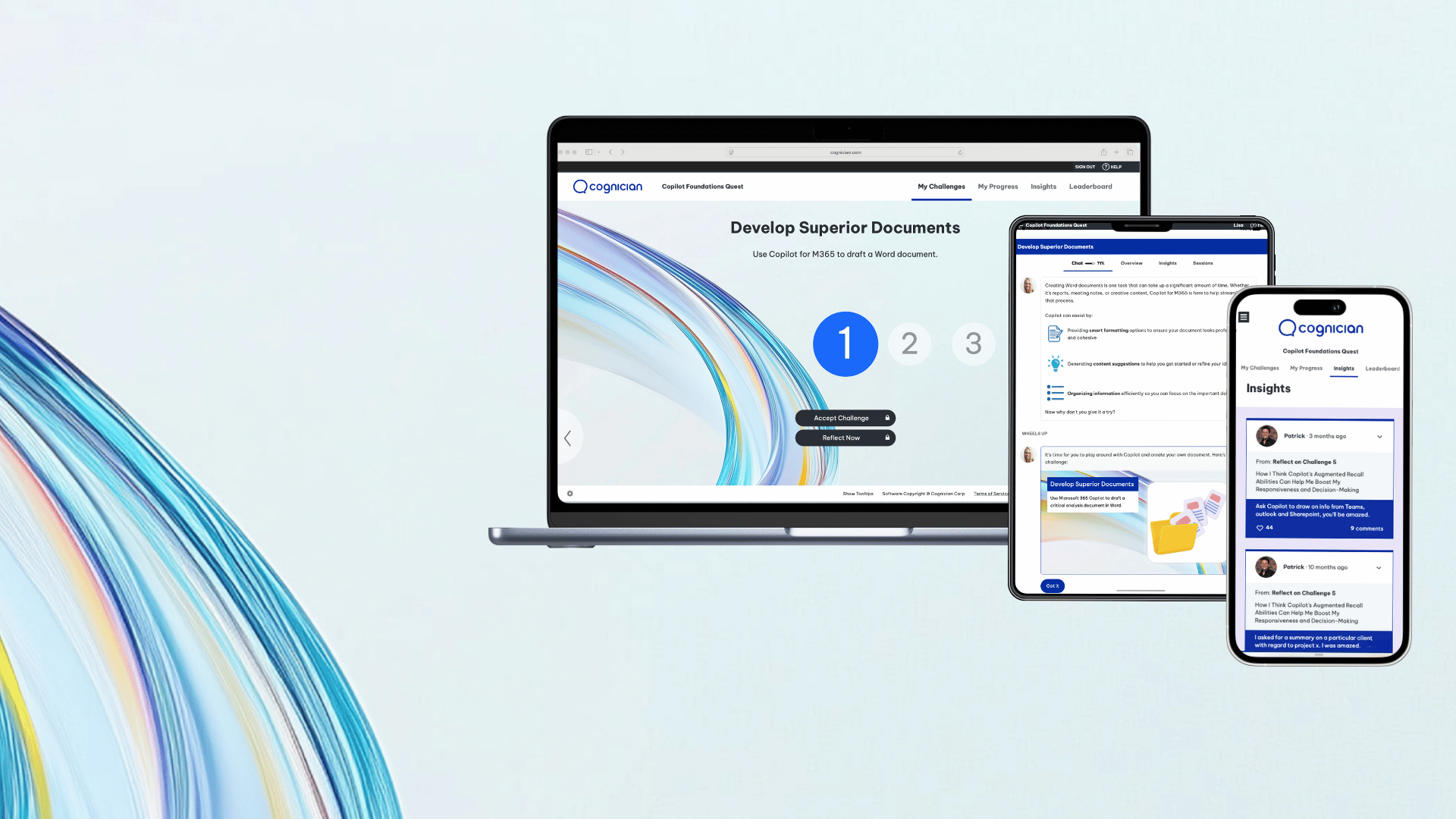Gamifying the adoption of new AI tools can boost motivation and make learning and using the tools both effective and enjoyable. Using points, challenges, and friendly competition encourages lasting behavior change. Read on for strategies to improve Copilot adoption.
When rolling out an AI tool like Copilot, one big question looms: How do we get people to actually use it? As a change leader, you'll have a set of non-negotiables. You'll seek the support of your execs. And you'll put in place a plan for activating adoption. But even then, real usage happens only when your audience is genuinely motivated. Ideally, that motivation is intrinsic. Your first job is to help employees answer, "What's in it for me?" But there are other motivators that work both intrinsically and extrinsically by tapping into people's relationships with their colleagues. And this is where gamification can shine as an engagement driver.
Why Gamification?
Gamification means applying game elements – points, challenges, competitions, rewards – to non-game contexts.
In a Copilot adoption program, this could look like a friendly competition among teams, a quest-like series of daily Copilot challenges, or a system of badges awarded for reaching new skill milestones.
The goal isn't to trivialize work; it's to tap into motivators like curiosity, achievement, and camaraderie. When done right, gamification triggers powerful emotions and positive experiences. It draws learners in and improves the chances of making learning stick. It can turn the process of using a new tool into an engaging journey of discovery.
But you can't expect to benefit from gamification by simply adding a points system to a boring lecture. Two principles make the difference between gamification as a gimmick or a game-changer.
Principle 1: Gamification Works Best When It Fits Your Culture
No two organizations – and no two teams – are alike. The game elements that ignite one group might fizzle with another. Your gamification strategy should match your organization's culture and preferences. Know your people: Are they competitive? Collaborative? Time-crunched and skeptical of 'fluff'? Tailor the experience accordingly.
At Cognician, we've learned to customize each program's gamified features for the client and the cohort. Sales-driven cultures with go-getter energy might benefit from a leaderboard and team-based competition that sparks friendly rivalry. More collaborative, knowledge-sharing cultures might focus on shared goals and peer recognition. Story-loving teams could experience the Copilot rollout as an epic quest or mission.
The key is to choose game mechanics that feel native to your workplace rather than imposed. By aligning with what people already care about, gamification becomes both fun and culturally resonant.
One major tech client put this into practice during a Copilot enablement sprint. Their two-week Copilot Quest engaged a competitive and goal-oriented sales team with daily challenges tied to their work and a team leaderboard. One participant said, "This didn't feel like training; it felt like a team challenge." Matching the tone to the audience optimized buy-in from day one.
Principle 2: Make Gamification Part of the Journey
For gamification to be effective, it must be meaningfully integrated into your Copilot activation experience. It shouldn't be an afterthought or a distracting side game. Game elements should reinforce – not replace – the behaviors you want to encourage.
Participants shouldn't be playing just for points or badges; they should earn points by using Copilot in valuable ways. These game elements increase the likelihood of participants completing the learning journey.
Tie Challenges to Real Work
In the Copilot Quest for our tech client, each daily challenge mirrored a real work scenario. One challenge asked participants to use a special agent to review their pipeline and identify deals needing attention. Another prompted them to open the Copilot Researcher agent to create an executive summary on a target client. Tasks were relevant to daily work, so the gamified program felt useful rather than distracting.
Guide with Narrative and Coaching
A digital coach avatar walked participants through each challenge step by step:
"Let's see how an AI agent can speed up building an Account Plan. What's one account you're working on? Now, ask the Researcher agent for an executive summary …"
After trying it, participants answered a reflection question:
"What did you find most useful, and what would you improve in the agent's response?"
These guided, chat-based elements turned abstract training into hands-on practice and personal insight.
Reward Reflection and Peer Sharing
After each challenge, we invited people to reflect on their experience and share an insight with their colleagues. Reflection and discussion were rewarded with points, thereby creating a supportive learning community rather than a frivolous contest.
When embedded like this, gamification feels purposeful and aligned with the adoption goals. This holistic, rewarding experience drives lasting behavior change far more effectively than superficial rewards.
Reinforce Habits
By integrating gamification into their daily workflow, participants stayed engaged and built real skills and habits. By day five or six, many were using Copilot outside the prescribed challenges. This is exactly the behavior change we'd hoped for.
Gamification Snapshot: Key Elements and Impact
Here are the key gamification elements we've used in Copilot adoption programs and how they drive adoption outcomes:
|
Gamification Element |
Impact on Adoption Outcomes |
|
Points and daily challenges |
|
|
Badges and milestones |
|
|
Leaderboards and competition |
|
|
Peer sharing (insights and social) |
|
|
Progress nudges and feedback |
|
A well-rounded gamification strategy addresses both extrinsic motivators (points, badges, competition) and intrinsic motivators (autonomy, mastery, social connection).
Extrinsic motivators get people over the initial activation goal: giving Copilot a try. Intrinsic motivators (learning something useful, feeling part of a community, overcoming a challenge) make the change stick. The game elements work in concert with the broader adoption strategy, not in isolation.
Ready to Press Play?
Driving adoption of Copilot (or any new technology) comes down to human behavior. Gamification nudges those behaviors to make adoption easier and more enjoyable.
By matching game mechanics to your culture and weaving them into the learning experience, employees feel excited to explore and master Copilot. They aren't adopting a tool because they have to. They're doing it because they want to. And because it's rewarding on multiple levels.
As a change leader, ask yourself:
- "How can we use gamification to energize our Copilot rollout?"
- "What kind of friendly competition or game would resonate most?"
- "Which behaviors do we need to see for Copilot to succeed, and how can we encourage them through playful incentives and challenges?"
It could be a department-wide Copilot challenge that celebrates creative use cases or a simple badge system for teams that integrates Copilot into projects. Start small – but start somewhere.
Our experience suggests that gamifying Copilot adoption succeeds when you engage people in the right way. Rather than a top-down mandate, you invite participants on an adventure to discover the value of Copilot themselves – helped along by a bit of gameful spirit.
So, game on! Activate your Copilot adoption plan. Infuse it with play and purpose, speed up adoption, and amp up enjoyment. My challenge to you is to give it a try in your own style. Craft a game that fits your culture, integrate it into your change program, and watch your colleagues thrive.
Or give us a call – we'll help you do it.


.png)
.png)

